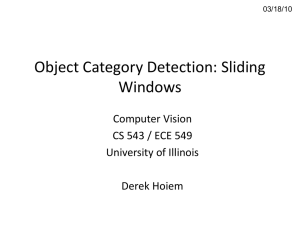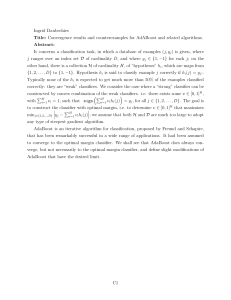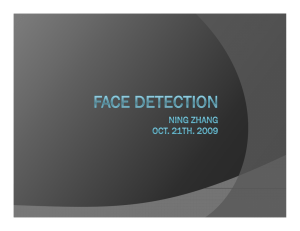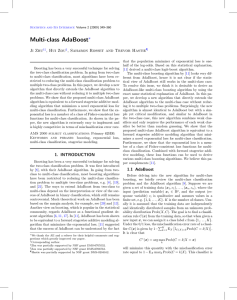Object Detection Using the Statistics of Parts Robust Real-time Object Detection
advertisement
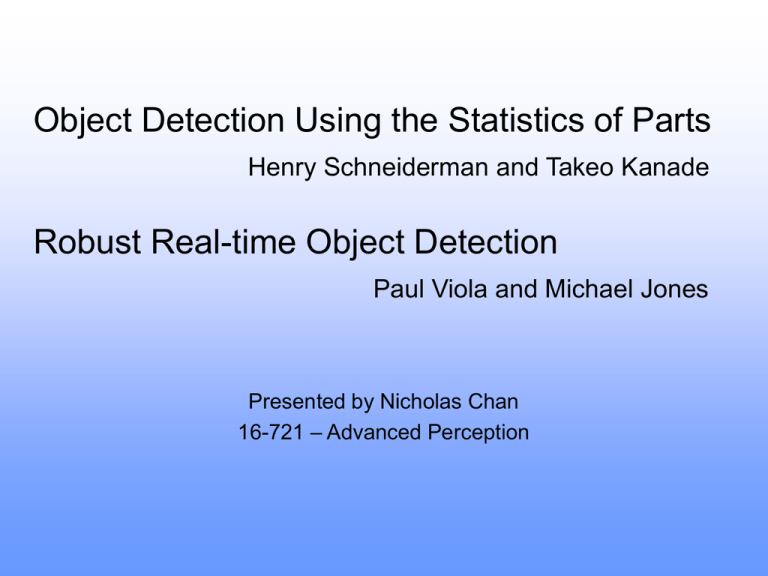
Object Detection Using the Statistics of Parts Henry Schneiderman and Takeo Kanade Robust Real-time Object Detection Paul Viola and Michael Jones Presented by Nicholas Chan 16-721 – Advanced Perception Object Detection Using the Statistics of Parts Henry Schneiderman and Takeo Kanade Object detectors trained using information on image “parts” So what’s a “part”? • Intuitively a part is a portion of an object… • For the purposes of image processing a part is a group of features that are statistically dependent. The assumption being that certain groups of pixels in an image tend to appear together and are (relatively) independent of other groups. Choosing parts First wavelet transform is applied to the image. This decorrelates the pixels, localizing dependencies and therefore producing more “focused” parts. A wavelet transform is the result of applying a series of wavelet filters to an image. The result is horizontal, vertical and diagonal responses for several scales. Choosing parts (2) Next, seventeen hand designed “local operators” are applied across the image. These local operators combine pairs of filter results from the wavelet transform. Some relate horizontal to vertical responses, whereas others relate responses to those of the same orientation but different scale. The output is discrete over 38 values. These are the “parts”. Are we even talking about “parts” of anything anymore..? Choosing parts (3) Intra-Subband Local operator Inter-frequency Local operator “Parts” Inter-orientation Local operator Inter-frequency/ Inter-orientation Box o’ Mystery Classification by parts Using this definition of “parts” and the base assumption that pixels within parts are independent of those outside parts, a classifier can be obtained: P( part r | object ) r P( part | non object) r A simple independence assumption… Learning by parts P(part | object) and P(part | non-object) are calculated with a simple MLE: P( part | object ) count ( part & object ) count (object ) AdaBoost is used to improve classification accuracy (more on this later). Detection examples Robust Real-time Object Detection Paul Viola and Michael Jones High-speed face detection with good accuracy The detector • A simple filter bank with learned weights applied across the image • But with some notable performanceboosting implementation tricks… Three big speed gains • Integral image representation and rectangle features • Selection of a small but effective feature set with AdaBoost • Cascading simple detectors to quickly eliminate false positives The integral image representation An image representation that stores the sum of the intensity values above and to the left of the image point. x, y IntegralImage(x,y) = Sum of the values in the grey region So what’s it good for? The integral image representation This representation allows rectangular feature responses to be calculated in constant time. Rectangular features are simple filters that have only +1 and -1 values and are… well… rectangles. Two-rectangle features Three-rectangle features I bet you can guess what these are called With an integral image and rectangular features, filter responses are just a fixed number of table lookups and additions away. Speed gain number two: AdaBoost selected features AdaBoost is used to select the best set of rectangular features. AdaBoost iteratively trains a classifier by emphasizing misclassified training data. Assigned feature weights are used to select the “most important” features. Top two features weighted by AdaBoost Intermediate results The face detector using 200 AdaBoost-selected features achieved a 1 in 14084 false positive rate when turned for a 95% classification rate. An 384x288 image took 0.7 seconds to scan. There are more improvements to be made… Speed gain number three: Cascading detectors Instead of applying all 200 filters at every location in the image, train several simpler classifiers to quickly eliminate easy negatives. Each successive filter can be trained on true positives and the false positives passed by the filters before it. The filters are trained to allow approximately 10% false positives. Image segment 200 Features Reject Accept Image segment 20 Features 20 Features Reject Reject … Accept Cascade improvements The cascading features provide comparable accuracy, but ten times the speed. Results Good accuracy with very fast evaluation. 0.067 Seconds per image. An average of 8 out of 4297 features evaluated. Detection examples
